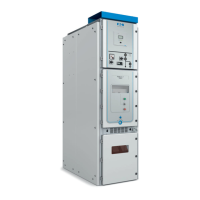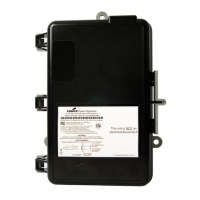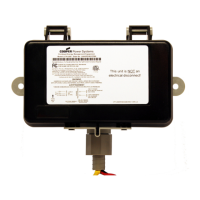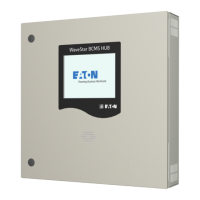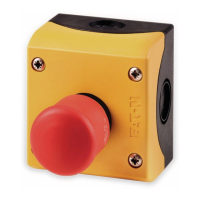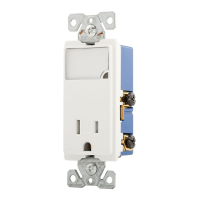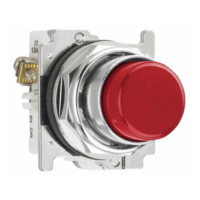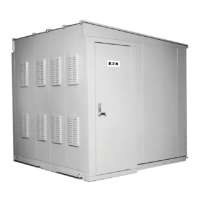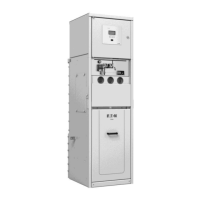10
Instruction Manual IM01500001E
Effective July 2011
Pow-R-Line switchboards
EATON CORPORATION www.eaton.com
IFS switchboard factory cabling
Some switchboards use cable/wire for some connections in lieu of
bus. Cabling is typical in Integrated Facility SystemE (IFSE) type
switchboards that incorporate lighting and appliance branch circuit
panelboards and dry-type distribution transformers within a switch-
board lineup.
Eaton’s selection of wire and cable follows UL 891 switchboard
procedures, National Electrical Manufacturers Association (NEMAT),
Federal Specification standards, and the National Electrical Code
standards for IFS switchboards.
The manufacturer identifies each phase conductor by means of
color-coded tape with markings “Factory Installed” in IFS switch-
boards. Markings are affixed to both the line and the load ends of
the conductors. Markings follow the industry-accepted phase colors.
(See Figure 18 and Table 1.)
Figure 18. Typical Phase “A” 240 Vac Wire Label
Table 1. Wire Label Color Codes
240 Vac Systems
and Below Nominal
Systems Above
240 Vac Nominal
Phase A Black Phase A Brown
Phase B Red Phase B Orange
Phase C Blue Phase C Yellow
Neutral White Neutral Gray
Ground Green Ground Green
Conductors installed by the manufacturer have been cut and
stripped to pre-determined lengths for connection between
components. When conductors are intended to run between
components in two different sections that are joined by the
manufacturer, the manufacturer will connect both the line and
the load ends of the conductors.
ote:N The National Electrical Code restricts the field installation of conductors
that run horizontally through switchboard vertical sections. Refer to the NEC
for specifics.
When there is a shipping split between sections that are cabled, the
factory connects one end of the conductors. The remainder of the
conductors are coiled and secured in the section with the connection.
Factory drawings included in the switchboard clearly indicate the
required field connections for the coiled conductors.
Inspect conductors/cables for damage. Any damaged conductors
must be replaced. Contact manufacturer for replacement.
Factory color-coded markings indicate phasing/neutral and are
marked on both the line and the load ends of the conductors.
Using the factory drawings, the installer connects conductors to
the component(s) indicated on the drawings, keeping phases
correctly oriented. Care should be taken in forming insulated
cables to ensure that no insulation is forced permanently against
edges of any metal parts.
Torque both line and load connections to values indicated on
the labeling on the switchboard. Refer to Appendix A, Table 2
for torque values.
Installation of incoming switchboard connections
DANGER
DE-ENERGIZE SWITCHBOARD—HAZARDOUS VOLTAGE. WILL CAUSE
SEVERE INJURY OR DEATH.
DO NOT work on electrical equipment while it is energized. Verify
that power entering the equipment is de-energized at the source.
Power is normally brought into a switchboard either by cable or by
busway (bus duct).
Remove structure covers as needed to access switchboard chassis
and components. Retain all cover mounting hardware and covers
for re-assembly. Protect hardware and parts from moisture, debris,
and damage.
ote:N As a minimum, all switchboard connections are rated for use with
75°C or higher rated conductors. When wire is used with temperature ratings
above 75°C, it shall be sized based on the ampacity of wire rated 75°C.
Wire/cabling
When cable connections are used, either mechanical set screw
or compression lugs are typically supplied. (See Figure 19.) See
factory drawing for specific lug terminations and wire ranges.
Some utilities make their own service entrance connections.
In these cases, the manufacturer typically supplies lug landing
provisions or a landing pad in lieu of lugs. These are designed to
the specific utility’s requirements. Refer to the manufacturer’s
drawings for specifics covering this connection.
Figure 19. Screw and Compression Lugs
Unless a switchboard specifically restricts entry to a single means
or area, cables may enter through the top, bottom, side, or back of
the main incoming section. These restrictions are typically required
to conform to wire bending space requirements of the NEC. Consult
the manufacturer’s drawings for conduit entry data.
Factory
installed
Mechanical Set
Screw Lug
Standard One-Hole
Compression-Type Lug
Optional Two-Hole
Compression-Type Lug

